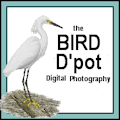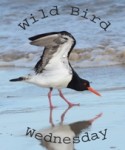Posted by: Ken @ 2:55 pm
 Update on the Rosy-Finches of Sandia Crest, New Mexico. The flag is waving– flocks of up to 150 Rosy-Finches are still visiting the feeders at Sandia Crest House. Feeders to remain up until end of this month or bears wake up, whichever happens first.
Update on the Rosy-Finches of Sandia Crest, New Mexico. The flag is waving– flocks of up to 150 Rosy-Finches are still visiting the feeders at Sandia Crest House. Feeders to remain up until end of this month or bears wake up, whichever happens first.
Saturation Banding
When we led weekend morning bird walks for the public at the Rio Grande Nature Center in Albuquerque, one of the highlights during migration seasons was our stop at the Rio Grande Research banding station, where Steve and Nancy Cox and the other volunteers usually had a few freshly caught specimens that everyone could examine at short range and benefit from the interesting presentations that Steve would usually give about each species. I m sure that these encounters with the banders turned many casual hikers into avid birders.In the course of spring banding, the team was so good at catching the local birds that a high percentage of our resident White-breasted Nuthatches, Black-capped Chickadees, and woodpeckers bore bands. When participants in the walks looked at a chickadee or nuthatch, they often made it a point to see if it was already banded. More often than not, it was, and, if there was no band, they often guessed that it was a bird that had hatched out that year.
This kind of efficiency is also evident with the rosy-finch banding program at
Sandia Crest House. As winter progresses, an ever larger percentage of
captured birds already has been banded. Having so many banded birds can
bother some photographers, who are looking for a “saleable image, ” as
they say. They view bands as detracting from the image of wildness. It
leads some photographers to try to find rosy-finches elsewhere. One
good place is the Taos Ski Valley, where the Kandahar Condomiums are
very birder-friendly and the view of the feeders is wonderful. However,
it seems that the Sandia Crest birds are now “contaminating” those up
in Taos!
Well, Nancy Cox told us that the banders met a photographer at the Crest last Sunday.
“He mentioned that he had photographed some rosy-finches in the Taos area. He said that one in 20 of them were banded. He sent us a photo of one of the banded birds. We can read 3 of the band numbers. Unfortunately the bands have 9 numbers and I really can’t confirm that it is one of ours. It makes us very interested in getting “our” birds outfitted with transmitters next year.”
The poor photographer did not want photos of banded birds and was trying to avoid them.
Migration Radar
few days. Tonight’s conditions do not appear favorable, as a cold front is moving across South Florida and is stalling out.
Good News For Red Knots
This press release appeared on Jersey Birds. The Governor supports the bill and will sign it into law. This legislation was not really “for the birds,” as it was the economic impact of avitourism that outweighed the loss of seasonal income of a few bait fisherman. It was a choice between a “multi-million dollar wildlife watching tourism industry” or a “few thousand dollars” revenue from permits.Trenton, NJ: New Jersey legislators overwhelmingly passed legislation to
save the Red Knot and other shorebirds from extinction. The legislation
will protect the critical shorebird food supply - Horseshoe Crab eggs - by
banning the harvest of Horseshoe Crabs in NJ. The bill now moves to the
desk of Governor Jon Corzine who has been a strong proponent for
conservation of the Red Knot and horseshoe crab.
“New Jersey is part of an intercontinental community that shares the
responsibility to sustain migratory shorebirds like the Red Knot by
preserving their vital food source,” said Assemblyman John McKeon (D).
“It is outrageous that we would allow these ancient species to be driven to
extinction when the ability to halt their decline is so readily at our
grasp.”
The legislation cleared the Assembly on Thursday, March 10 by a vote of
70 to 6 and the Senate on Monday, March 17 by a vote of 39 to 0.
“New Jersey plays a vital role in the centuries-old relationship between
Horseshoe Crabs and Red Knot birds,” said Senator Joseph Vitale (D).
“Without the ability of the Red Knot to feed on our state’s beaches along
their journey from South America to the Arctic, their numbers will continue
to shrink adding to their eventual extinction. We have a sacred obligation
to save these species and an immediate opportunity to do so.”
Red Knots, a robin-sized shorebird, come to the Delaware Bay each spring
after flying non-stop from Brazil. Knots rely on a superabundance of excess
horseshoe crab eggs to nearly double their body weight in less than 2 weeks,
before flying non-stop to their breeding grounds in the Arctic.
‘”New Jerseyans are proud of the Garden State’s natural heritage,” said
Senator Robert Gordon (D). “We need to take swift action to ensure
the Red Knot can be enjoyed by future generations on the Bayshore
instead of history books.”
Due to the reckless overharvest of horseshoe crabs and a subsequent rapid
decline of their eggs, the Red Knot population has plummeted from over
100,000 to only 14,800 currently wintering in Tierra del Fuego, at the
southern tip of South America.
“Over twenty leading scientists from four continents agree that the Red Knot
is facing imminent extinction unless we take strong measures to secure their
food supply,” said Assemblyman Douglas Fisher (D). “Conservation is
critical to the economy of the Garden State. Each year thousands of
wildlife watchers descend on the Delaware Bay to view shorebirds
contributing millions of dollars to local businesses.”
“The Delaware Bay, home to the largest horseshoe crab population and
one of the largest shorebird assemblages in the world, is our Serengeti,” said
Eric Stiles, Vice President of Conservation at NJ Audubon Society. “We
applaud the successful efforts of legislators to secure this treasure and ensure
we don’t cook the golden goose by destroying a multi-million dollar wildlife
watching tourism industry.”
“The legislature has really stepped up to protect the natural resources of
the Delaware Bay,” said Tim Dillingham, Executive Director, American
Littoral Society. “This action will help pull the Red Knot back from the
brink of extinction.”
“We commend the legislature to overturn the outrageous act of the NJ
Marine Fisheries Council taking special interests over the public interest,”
said Jeff Tittel, Executive Director, Sierra Club - New Jersey Chapter.
“For a few thousand dollars worth of permits you can no longer destroy
an entire species and an ecosystem.”
The Delaware Riverkeeper Maya van Rossum commented that “the
legislators saw the clear and compelling need to protect this vital natural
treasure. I commend the strong bi-partisan support and leadership.”
“The action of the New Jersey legislature to protect the Red Knot is the
only responsible course,” said Darin Schroeder, American Bird
Conservancy’s Executive Director for Conservation Advocacy. “New
Jersey is demonstrating real leadership, doing what other states and
the federal government should be doing. Conserving horseshoe crabs
gives the Red Knot a chance to rebound.”












